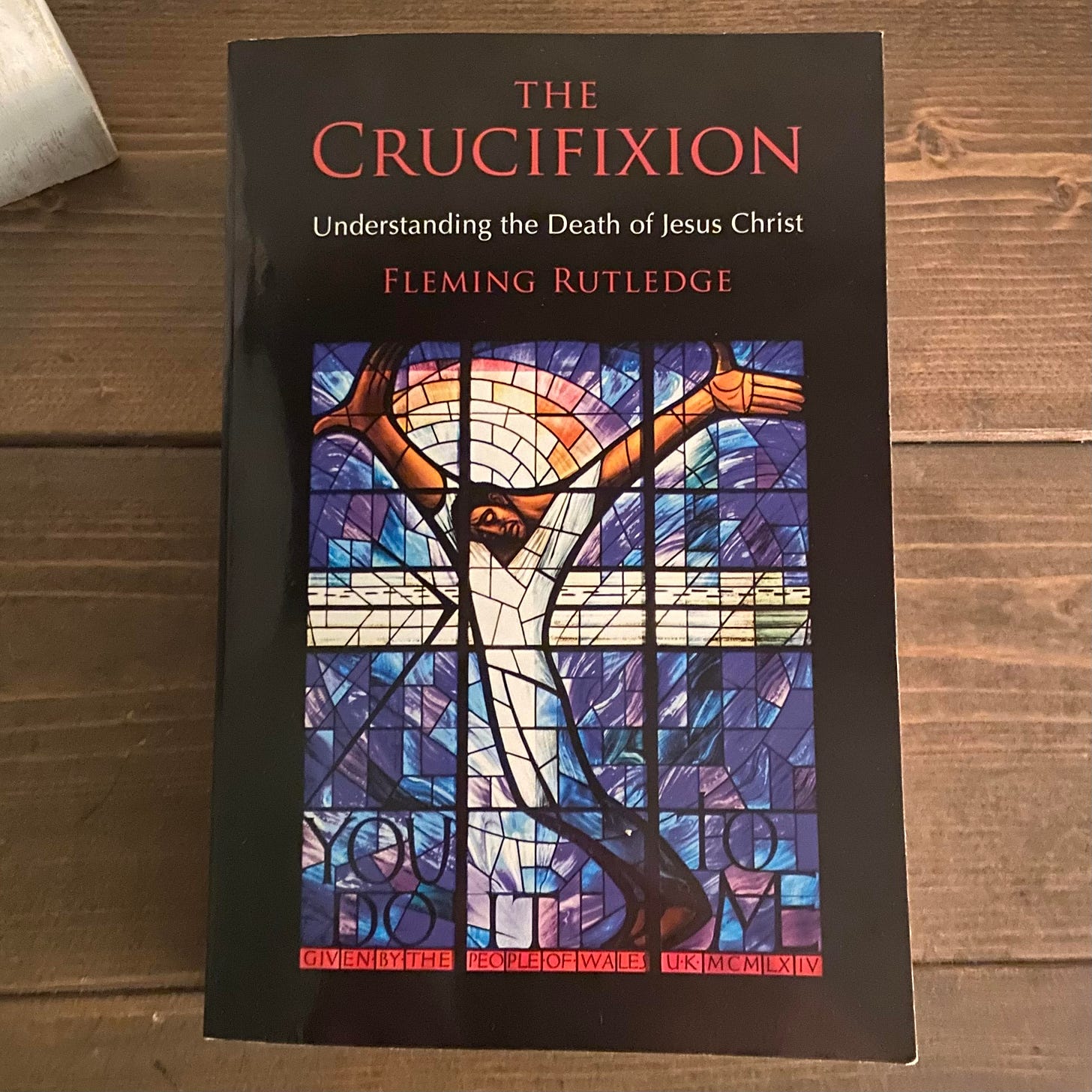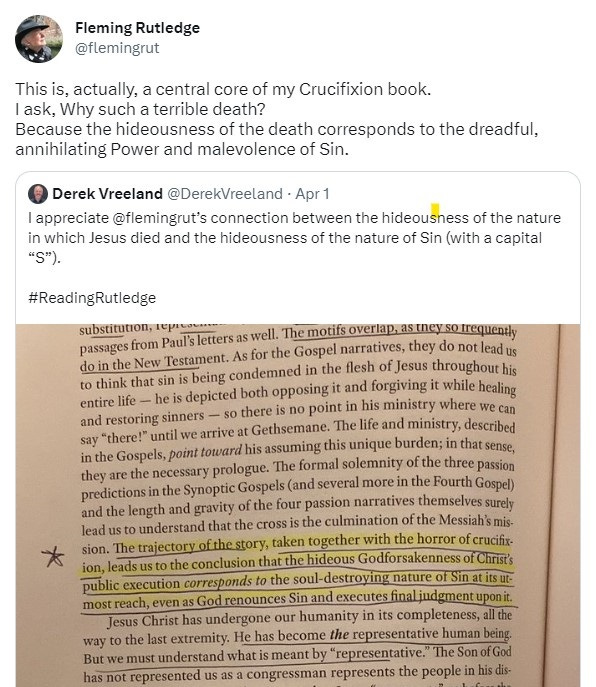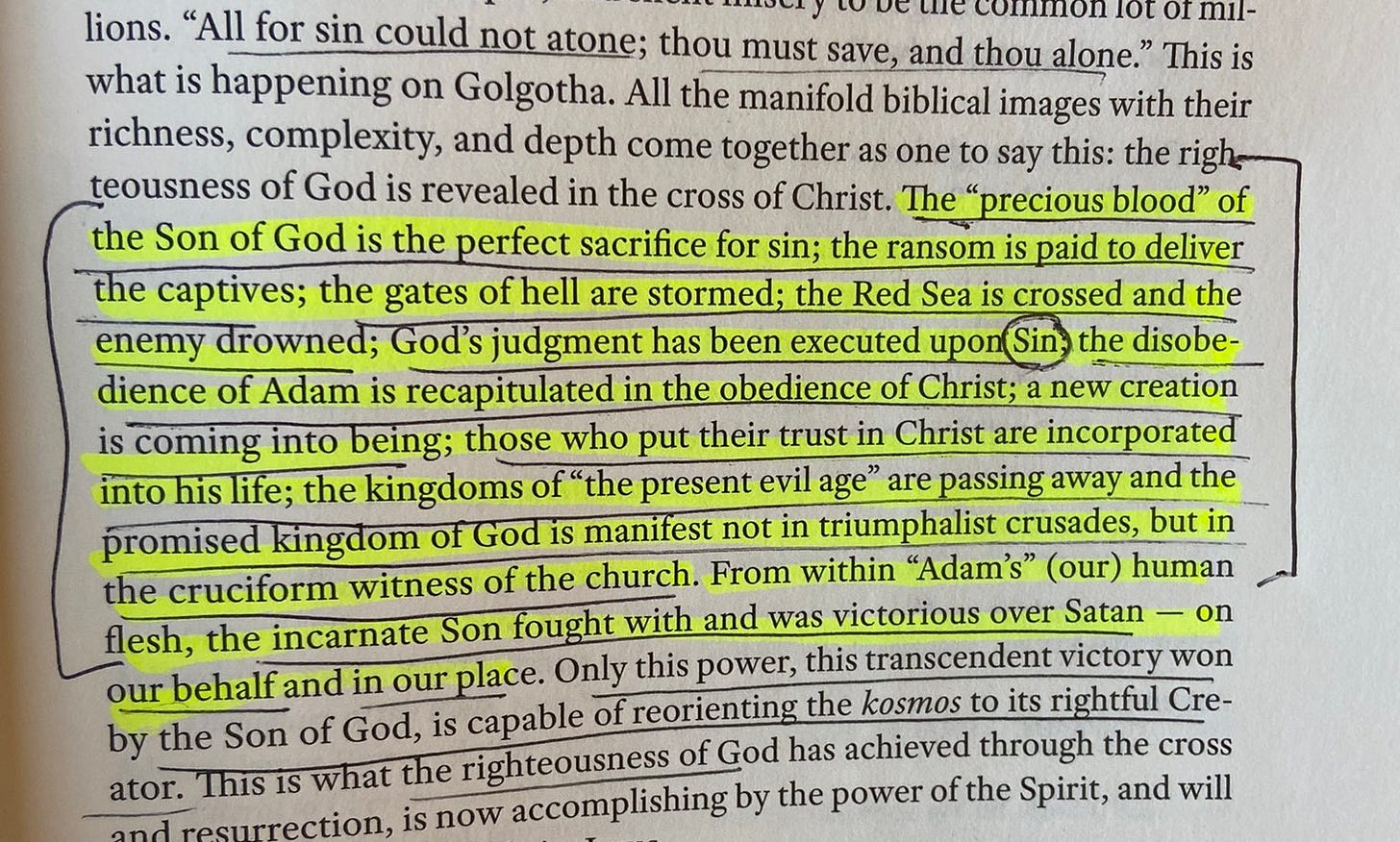Recapitulation, Rutledge's Concluding Chapter, and Final Thoughts
Conclusion to #ReadingRutledge
Happy Easter! Christ is risen!
I hope you are joining in the joy of Easter after our Lenten reading journey through The Crucifixion. Remember that on the Christian calendar the Easter celebration is not one day, but an entire seven-week feast! The Lenten fast is over and now it is time to feast.
If you fell behind in our reading schedule, I’d encourage you to continue reading during Eastertide. I fell a little behind during Holy Week but I was able to finish on Maundy Thursday. This book is stunning, sweeping in its scope, and a theological masterpiece! I’ll save the rest of my final thoughts for the end of the post. First let’s walk through the eighth and final motif Rutledge presents: recapitulation.
Jesus and the Takeover
The recapitulation metaphor made popular by Irenaeus in the second century is built upon Paul’s description of Jesus as the second Adam.
“Yet death exercised dominion from Adam to Moses, even over those whose sins were not like the transgression of Adam, who is a type of the one who was to come. But the free gift is not like the trespass. For if the many died through the one man’s trespass, much more surely have the grace of God and the free gift in the grace of the one man, Jesus Christ, abounded for the many.” - Romans 5:14-15 NRSV
Adam is a type, the prototypical human being, who led humanity into sin and subsequently death. Jesus come as our human representative to redo and undo what Adam did. Paul casted Adam in a metaphorical light. We were in Adam and we died in Adam (1 Corinthians 15:22). Jesus comes as the new Adam so that we can experience new life free from Death’s dominion. For Rutldege, “The story of Adam and Christ is a story of incapacity on the part of Adam and potency on the part of God” (545). What we could not do in our weakness, God in Jesus did for us.
Rutledge notes that the recapitulation motif does not give us a full picture of the crucifixion, but it helps in that it draws the incarnation of Jesus into the story of our redemption. What recapitulation misses is the horrific nature of the crucifixion, an important and often overlooked aspect of atonement. The hideousness of the cross corresponds to the hideousness of sin. Rutledge says this idea is the central core of the book.
Through his act of recapitulation we become, by the Spirit, the new humanity living in the new Adam. Jesus is taking over our lives as the Second Adam ruling in the place of Sin and Death. In this regard, recapitulation is close to both Christus Victor and substitution. Jesus’ recapitulation includes a victory over demons and evil and acknowledges the inadequacy of human ability to resist the draw of the “dark side.”
This takeover is a demonstration of God’s righteousness, that is, God power to set right what has gone wrong in God’s good world. We are incorporated into this work of rectification by Jesus.
Rutledge’s Concluding Chapter
The final chapter doesn’t necessarily sum up what has come before, but rather extends the implications of the crucifixion of Jesus to the redemption of the ungodly. Religion has the history of dividing people but “the crucifixion of Jesus Christ,” she writes, “puts an end to all these religious categories that separate people from one another” (577). The human predicament is deep enough that we all find ourselves in need of rectification. We need more than forgiveness; we need mending (587). It is the work of God, i.e. the righteousness of God, to rescue, redeem, and restore us.
The best definition of the righteousness of God is the simplest one: it is the power of God to make right what has been wrong. And what has been wrong since ‘Adam’ is the captivity of the entire human race to Sin, Death, and the judging and condemning voice of the Law. (590)
God accepts us Just as we are but that is not the end of the story. God accepts me just as I am but God does not intend for me to stay as I am. God’s righteousness comes to transform and reshape us.
Beyond our own spiritual formation, there are evil and true horrors in our world that need to be addressed and made right. We can work to make things right as we advocate for justice but ultimately setting things right is God’s job.
Human agents can administer justice, up to a point, and human forgiveness can certainly — and often does — carry with it the power of God. But actual rectification — making right what has been wrong so that the wrong no longer exists — is impossible for human beings. The coming of the Day of the Lord (Old Testament), the new creation (Second Isaiah and Paul), the kingdom of God (the Synoptic Gospels), eternal life (John), the new Jerusalem (Revelation) will not be accomplished through human means, but only through the working of God. (598)
At the end of her concluding chapter on page 611, Rutledge does offer a sweeping summary of the book.
I circled the word “Sin” because it is important to see that the biblical metaphor of “penal” substitution is not that God’s judgment has been executed upon the Son, but on Sin. Sin and death are the problems for which the death of Jesus is the solution.
Final Thoughts
Thank you for joining me on this Lenten reading journey. If you feel behind and haven’t finished The Crucifixion, continue reading through Eastertide. I have heard from so many people who have been reading along and honestly I never expected a simple Tweet about a reading schedule to draw such attention!
This book is hands down the best and most important book on the death of Jesus I have ever read! It will continue to remain a reference book for me to use for years to come. I appreciate her wit and insight. I appreciate how she stayed close to the biblical witness and drew out implications for those of us who are tasked with preaching the foolishness of the cross.
I do wish she would have drawn out the kingdom implications of the crucifixion. I found that lacking in her wide sweeping review of the various meanings of the cross. The death of Jesus is not only rescuing but it is revealing. The cross reveals who God is, who we can be as a cruciform people, and how the kingdom comes. John, more than the Synoptics, draw out some of the kingdom implications of the cross. Jesus died as the “King of the Jews” and as we look back at the cross through the resurrection, we see that Jesus is indeed King of the nations. So while she omitted some of this material you can read more of this perspective in N.T. Wright’s The Day the Revolution Began and my little reader’s guide N.T. Wright and the Revolutionary Cross.
Grace and peace to you!






I like to think of self giving and self sacrifice as self engaging. If only looking at it as giving and sacrifice it is only one way and their is no receiving, no relationship. Jesus self engaged by taking on our sin so that He could better understand our situation and in return we could better understand humanities creation as defined by Him, engaged and so completely intertwined in the Trinity that by seeing Jesus you see God and the Holy Spirit. By abolishing death, Jesus gets to have relationship with all of God's creation forever and we get eternal life in Him. I like to think that Jesus's message is connection to all at any cost as evidenced by the Cross.
Sometimes I look at the word "love" as "connection". If there is no connection in a relationship then there really is no relationship. If there is no relationship, then there is no good. Good cannot exist without love in which love is truly the only good.
Thank you Derek for letting us in on your journey with this book and a chance to engage in it with you!